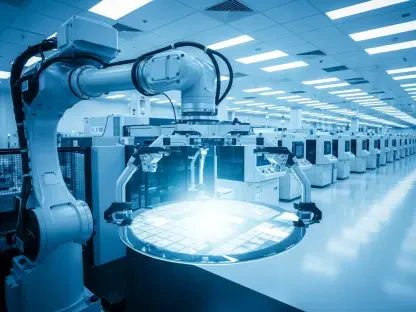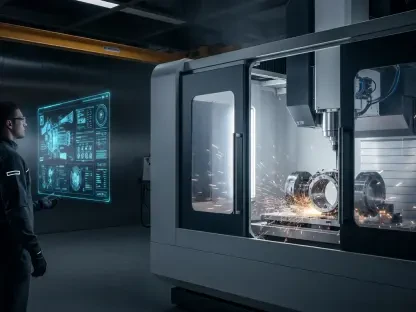In a world increasingly shaped by automation and artificial intelligence, China has emerged as a formidable leader in the robotics industry, setting a pace that challenges global competitors and redefines technological frontiers. The People’s Republic of China (PRC) is not merely participating in this revolution; it is driving it with a calculated blend of government strategy, industrial prowess, and relentless innovation. From dominating industrial robot installations to pioneering humanoid systems that blend cognitive and physical capabilities, China’s ambitions are reshaping how the world envisions the future of machines. This surge is backed by a staggering 276,000 industrial robots installed in 2023 alone, a figure that towers over other nations and underscores a clear intent to lead. Beyond raw numbers, there lies a deeper narrative of a nation transitioning from dependency on foreign technology to becoming a standard-setter in robotics and embodied AI. This article delves into the multifaceted approach fueling China’s ascent, examining the policies, financial mechanisms, technological strides, and strategic vision that position it at the forefront of this global transformation. It’s a journey of coordinated effort, where every layer of society—from central planners to regional innovators—plays a role in crafting a robotics powerhouse. As the stakes rise, understanding these dynamics offers critical insight into what lies ahead for technology and economic competition on a worldwide scale.
A Unified National Push
China’s robotics dominance is rooted in a “whole-of-nation” strategy that harnesses the collective strength of government, industry, and academia under a singular vision of global leadership, showcasing a unified approach to technological advancement. Since 2015, Beijing has orchestrated a cohesive framework where central directives provide the overarching goals, while local entities execute with tailored precision. This isn’t a fragmented effort but a synchronized march, ensuring that resources and talent across the nation align toward advancing robotics as a pillar of national power. State agencies issue mandates, private firms innovate under guided incentives, and universities fuel research, creating a robust ecosystem. This approach allows for rapid scaling of technologies, from factory automation to experimental AI-driven systems, positioning China to outmaneuver competitors who often lack such unified resolve. The synergy between top-down planning and bottom-up implementation is a hallmark of this strategy, enabling adaptability while maintaining focus on long-term objectives.
This national alignment also fosters an environment where experimentation and innovation thrive under a protective umbrella of policy support. Local governments, empowered to interpret central goals, bring regional strengths into play, ensuring that no part of the country lags in contributing to the robotics surge. For instance, while one province might focus on manufacturing applications, another hones in on service-oriented robots, creating a diverse yet interconnected network of progress. This model minimizes redundancy and maximizes impact, allowing China to address multiple facets of robotics simultaneously. The result is a dynamic system where national ambition is not just a slogan but a lived reality, driving advancements at a pace that challenges even the most established tech economies. This unified push is a key reason why China’s robotics landscape looks so formidable on the global stage.
Policies Shaping the Future
The foundation of China’s robotics ascent lies in a series of meticulously crafted policies that have evolved over the past decade to address both immediate needs and futuristic goals, starting with the “Made in China 2025” initiative in 2015. Robotics was identified as a critical sector for achieving technological independence and global market dominance. This wasn’t a static plan; it morphed through frameworks like the Robot Industry Development Plan (2016–2020) and the 14th Five-Year Plan (2021), each refining targets to include intelligent manufacturing and broader societal applications. By 2023, the “Robotics+” action plan marked a bold shift toward embodied AI, focusing on robots that integrate cognitive intelligence with physical dexterity. These policies are not mere documents; they are roadmaps that pinpoint weaknesses, such as reliance on imported components, and channel efforts toward self-reliance and innovation.
Beyond setting ambitious targets, these policies create a structured environment where progress is measurable and accountability is clear, prioritizing specific areas like humanoid robotics for healthcare and logistics. They reflect a vision that extends beyond industrial use to human-centric solutions. This evolution also tackles systemic issues, such as supply chain vulnerabilities, by incentivizing domestic production of critical technologies. The pragmatic nature of these plans ensures that they adapt to global trends and internal challenges, maintaining relevance in a fast-changing tech landscape. As a result, China’s policy framework serves as both a catalyst and a stabilizer, propelling the nation forward while mitigating risks of overreach or misallocation. This strategic foresight in policy-making is a cornerstone of why China stands as a leader in robotics today.
Financial Backing as a Catalyst
Fueling China’s robotics revolution is an unparalleled level of financial commitment from both national and local levels, creating a robust support system for innovation and deployment. The central government has rolled out massive initiatives like the $8.2 billion National AI Industry Investment Fund in 2023, channeling capital directly into frontier technologies that underpin advanced robotics. This isn’t just about funding research; it’s about building an entire ecosystem where startups, established firms, and academic institutions can access the resources needed to experiment and scale. Such financial muscle lowers the barriers to entry, allowing even nascent ideas in embodied AI to find footing in a competitive market. The scale of investment sends a clear message: China is fully committed to robotics as a driver of future economic strength.
At the regional level, a competitive “subsidy race” amplifies this financial push, with provinces and cities vying to become hubs of robotic innovation by offering millions in incentives. These subsidies often target specific needs, such as establishing innovation centers or supporting consumer adoption of smart robots, creating a fertile ground for rapid development. However, this aggressive funding approach isn’t without pitfalls; concerns about overcapacity and inefficient allocation linger as regions sometimes prioritize quantity over quality. Despite these risks, the sheer volume of capital flowing into the sector ensures that China’s robotics ambitions are not constrained by budgetary limits. This financial strategy transforms abstract policies into tangible outcomes, cementing China’s position as a powerhouse by ensuring that ideas have the backing to become reality.
Overcoming Technological Hurdles
While China’s robotics industry has made remarkable strides, it continues to grapple with significant technological challenges, particularly its historical dependence on foreign components like high-precision actuators and servo motors. For years, this reliance has been a bottleneck, exposing vulnerabilities in supply chains and limiting full autonomy in production. National policies have consistently highlighted the urgency of localization, aiming to develop a self-sufficient ecosystem for critical parts well before external pressures like export controls intensified. The drive for domestic innovation in areas such as sensors and motion control systems is not just a reaction to global tensions but a proactive step toward long-term resilience. This focus on closing technological gaps is central to China’s strategy, as it seeks to transform from a consumer of imported tech to a creator of cutting-edge solutions.
Efforts to overcome these hurdles are gaining traction, though the path remains complex and demanding, as research and development initiatives are heavily funded to tackle specific weaknesses. One key focus is the integration of unified AI architectures for seamless robot functionality. While progress is evident, particularly in industrial applications, the sophistication required for advanced humanoid systems still poses challenges. China’s commitment to addressing these issues is unwavering, with every new policy iteration emphasizing breakthroughs in homegrown technology. The stakes are high—achieving self-reliance in robotics hardware could redefine China’s role in global markets, reducing external dependencies and enhancing competitiveness. This ongoing battle against technological bottlenecks is a defining aspect of China’s journey to leadership in the field.
Leveraging Cross-Industry Strengths
A distinctive strength in China’s robotics push is the phenomenon of “industrial migration,” where major players from the electric vehicle (EV) and technology sectors pivot their expertise into robotic development. Companies like BYD and XPeng, known for their advancements in autonomous driving, are repurposing technologies such as LiDAR, sensor fusion, and AI processors to enhance robot navigation and decision-making capabilities. This cross-pollination of skills not only accelerates innovation but also slashes costs—BYD, for example, achieves reductions of 30–40% by producing components in-house. Such synergies allow for faster transitions from prototype to production, giving China a competitive edge in scaling robotics applications across diverse fields.
This cross-industry collaboration extends beyond EV giants to tech powerhouses like Huawei and ByteDance, which bring their own strengths to the table. Huawei’s Embodied AI Industry Innovation Center in Shenzhen exemplifies how tech infrastructure can bolster robotics research, while ByteDance contributes to logistics automation with significant robot deployments. This blending of sectors creates a unique advantage, leveraging existing manufacturing capabilities and digital expertise to address robotics challenges holistically. The result is a vertically integrated approach that streamlines development and positions China to redefine global supply chains. By harnessing these overlapping strengths, China not only speeds up its robotics timeline but also builds a model of innovation that other nations struggle to replicate, further solidifying its leadership.
Regional Diversity in Innovation
China’s robotics revolution is not a monolithic effort centered in one city or region; it thrives on a decentralized yet coordinated model where local governments adapt national directives to their unique industrial landscapes. Shanghai, with its robust healthcare infrastructure, channels resources into medical robotics, developing systems for surgeries and patient care. Meanwhile, Beijing prioritizes eldercare robots to address demographic challenges like an aging population. This regional specialization ensures that national goals are met through diverse applications, creating a comprehensive robotics ecosystem that touches multiple aspects of life and industry. The adaptability of local policies to specific strengths prevents overlap and fosters complementary growth across the country.
Key tech hubs like Shenzhen and Hangzhou play a pivotal role as incubators for startups and cutting-edge research, driving innovation at a grassroots level while provinces such as Zhejiang and Guangdong, with deep manufacturing roots, focus on scaling industrial robotics and integrating automation into their vast factory networks. This multi-nodal approach spreads the benefits of robotics development nationwide, ensuring that economic and technological gains are not concentrated in a single area. By aligning local priorities with national ambitions, China maximizes its collective impact, creating a distributed network of progress that fuels its global standing. This regional diversity, underpinned by a shared vision, is a critical driver of why China’s robotics industry appears so dynamic and far-reaching in its influence.
Dominating Global Metrics
China’s position in the global robotics arena is underscored by hard data that highlights both its achievements and areas for growth, particularly in 2023 when the nation installed 276,000 industrial robots, a number that far surpasses any other country and reflects its unmatched capacity for deployment. This dominance in volume showcases China’s industrial might and its ability to integrate automation at scale across manufacturing sectors. However, when it comes to intellectual property, China still trails behind leaders like Japan and South Korea, indicating a gap in original innovation. Closing this divide is a priority, with projections showing China holding 60% of global AI-driven robotics patents by the current year, a testament to its accelerating research momentum.
Beyond installations and patents, China’s influence is evident in the academic sphere, where research publications in robotics have surged dramatically over recent years. This 545% increase in output from 2015 to 2022 signals a growing pool of expertise and ideas that are shaping future technologies. These metrics are more than just numbers; they represent China’s expanding role in defining industry standards and pushing the boundaries of what robots can achieve. The focus on both quantity and quality in research and deployment positions China as a formidable force, narrowing the innovation gap with traditional leaders. As these trends continue, the global robotics landscape is increasingly likely to bear China’s imprint, challenging competitors to keep pace with its relentless progress.
Pioneering Humanoid Systems
While China’s industrial robotics sector is already a global leader, the frontier of humanoid robotics—machines designed to emulate human behavior and interaction—represents the next leap forward. Currently in its early stages, this field is driven by university-led research and sustained by long-term capital investments rather than immediate commercial returns. National policies have begun to prioritize humanoid systems, recognizing their potential to transform industries like healthcare, logistics, and eldercare. Market projections are striking, estimating growth from $2.8 billion in 2024 to a staggering $100 billion by 2030, reflecting the immense expectations pinned on this emerging technology. China’s commitment to this area signals a vision that extends beyond automation to redefining human-machine collaboration.
Developing humanoid robots, however, presents formidable challenges, from creating unified AI architectures that blend cognition with physical action to engineering lightweight, durable materials for practical use. These technical hurdles require breakthroughs that are still in progress, yet China’s resource allocation and policy focus are geared toward overcoming them. The potential applications are vast—imagine robots assisting in surgeries, managing warehouses, or supporting aging populations with daily tasks. By investing heavily in this space, China aims to not just catch up but to lead in a domain that could shape the future of technology. This pursuit of humanoid innovation underscores a broader ambition to push robotics into realms once thought to be science fiction, cementing China’s role as a trailblazer.
Transforming Supply Chain Dynamics
China’s robotics strategy extends beyond building machines to fundamentally altering global supply chains through vertical integration and self-reliance. By leveraging infrastructure from the EV sector, companies are creating end-to-end production systems that control every stage, from component manufacturing to final assembly. This approach, seen in firms like BYD, dramatically cuts costs and enhances efficiency, offering a competitive edge that challenges international players. The integration of tech capabilities, such as AI and sensor technology, further streamlines robotics production, making China a hub for cost-effective, high-quality output. This shift is not just operational; it’s strategic, aiming to reduce dependence on foreign supply networks and build a resilient domestic ecosystem.
The implications of this transformation are profound for global markets, as China’s model could redefine how robotics are produced and distributed worldwide, setting a new standard for the industry. By establishing dominance in supply chain control, China positions itself to influence pricing, standards, and availability, creating ripple effects across industries. Competitors may find themselves forced to adapt to a landscape where China holds significant leverage, particularly in cost-sensitive sectors. This push for supply chain autonomy aligns with broader national goals of technological independence, ensuring that external disruptions have minimal impact on progress. As China continues to refine this integrated approach, it lays the groundwork for a new era in robotics manufacturing that could tilt the balance of economic power in its favor.
Charting the Path Ahead
Reflecting on China’s robotics journey, it’s evident that a meticulously coordinated effort spanning policy, finance, and industry had already reshaped the global landscape in recent years, altering the competitive dynamics significantly. The “Made in China 2025” initiative and subsequent frameworks had set a trajectory of dominance, with industrial robot deployments outpacing rivals and research output soaring. Humanoid robotics, though still emerging, had shown transformative promise, backed by policies that prioritized long-term innovation over short-term gains. Despite persistent challenges in intellectual property and supply chain autonomy, China’s strides in patents and market expansion had narrowed gaps with established leaders, positioning it as a formidable force.
Looking forward, the next steps involve sustaining this momentum through targeted solutions and global engagement, ensuring that progress in technology and innovation continues unabated. Policymakers and industry stakeholders should focus on refining subsidy mechanisms to avoid overcapacity, ensuring investments yield sustainable innovation rather than excess. Strengthening international collaboration on standards could also help balance China’s self-reliance goals with global integration, fostering a competitive yet cooperative environment. Additionally, accelerating breakthroughs in humanoid technologies will be crucial, as these systems hold the potential to redefine societal and industrial norms. As China continues to chart this path, close monitoring of its strategies will be essential for understanding how robotics—and technology at large—evolves in the coming years, offering lessons and challenges for the world to navigate.









